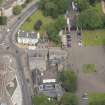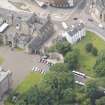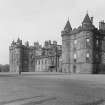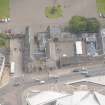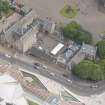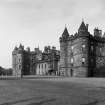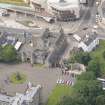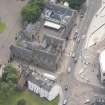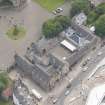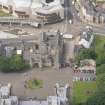Edinburgh, Holyrood Palace, Palace Yard, Fountain
Fountain (19th Century)
Site Name Edinburgh, Holyrood Palace, Palace Yard, Fountain
Classification Fountain (19th Century)
Alternative Name(s) Palace Of Holyrood; Palace Of Holyroodhouse
Canmore ID 52384
Site Number NT27SE 35.12
NGR NT 26856 73907
Datum OSGB36 - NGR
Permalink http://canmore.org.uk/site/52384
- Council Edinburgh, City Of
- Parish Edinburgh (Edinburgh, City Of)
- Former Region Lothian
- Former District City Of Edinburgh
- Former County Midlothian
See also NT27SE 35.17 (Statue to Queen Victoria).
Aerial Photography (1971)
Oblique aerial photographs of Holyrood Palace and Abbey, Edinburgh, by Mr John Dewar in 1971.
Project (1997)
The Public Monuments and Sculpture Association (http://www.pmsa.org.uk/) set up a National Recording Project in 1997 with the aim of making a survey of public monuments and sculpture in Britain ranging from medieval monuments to the most contemporary works. Information from the Edinburgh project was added to the RCAHMS database in October 2010 and again in 2012.
The PMSA (Public Monuments and Sculpture Association) Edinburgh Sculpture Project has been supported by Eastern Photocolour, Edinburgh College of Art, the Edinburgh World Heritage Trust, Historic Scotland, the Hope Scott Trust, The Old Edinburgh Club, the Pilgrim Trust, the RCAHMS, and the Scottish Archive Network.
Field Visit (16 October 2002)
Octagonal stone fountain, decorated with a lion sejant, top (facing W.) holding sword and sceptre in forepaws, seated on an orb. Below that is a large crown supported by columns against which stand four halberdiers (Blair, Montgomery, Campbell and Blackadder) wearing hats, ruffs and short 'knickerbockers'. Below the halberdiers (clockwise from NE. corner) are (1) Rizzio playing a flute; (2) Queen Margaret, crowned, looking up and holding a book; (3) John Cunningham, Town Drummer of Linlithgow, a drum at his left hip; (4) Lady Cramford with a hawk perched on her finger and a dog by her left side; (5) the Earl of Stair, a sword
behind him and a gun in his hands, the barrel of which rests on a long forked stick; (6) Queen Mary, holding a sceptre in her right hand; (7) Sir John Cope, wearing hat, ruff, elaborate breeches and cloak; (8) Arabella of France, holding a mask in her right hand and a glove in her left.
Below each figure is an attached column. Between each of the capitals is a grotesque head with a metal tongue [water spout?]. Below each grotesque head
is a panel carved in low relief with foliage. On either side of the panels is a buttress. On the buttress below Rizzio is a lion, with a crown around
its neck, holding a shield. On the buttress below Cunningham is a unicorn,
with a crown around its neck, holding a shield decorated with the arms of James V.
On the buttress below the Earl of Stair is a stag, with a crown around its neck, with two diamond-shaped shields on its left shoulder. On the buttress below Sir John Cope is a winged dragon holding a diamond-shaped shield.
Below the buttresses are the heads of Edward I, Queen Mary and the Duke of Buckingham [all below Rizzio]; the heads of Archie Simpson (Dunfermline Abbey
fool), Binnock (who deceived the English at Linlithgow) and Elizabeth Blackwood [all below Cunningham]; the heads of Young Earl of Kent, Abbot of St Andrews and Oliver Cromwell [all' below Lady Cramford]; George Buchanan (Court fool) stabbng the Duke of Devonshire [below the Earl of Stair]; the head of Grieve on Jock Howison's farm, the head of Shakespeare, and the fool in the Court of
Elizabeth [all below Queen Mary]; the Duke of Essex and Lola Irondale with a dog [below Sir John Cope]; the heads of John Milburn of the Covenanters, a cherub
and Elizabeth Milburn [all below Arabella of France]. Below Queen Margaret are a rose, a thistle and a lily.
The buttresses between those decorated with heraldic beasts are carved with foliate forms and have two half-length figures at their base.
On each side of the base of the fountain is a lion's head.
The Builder of 6 March 1858 reported that 'Sir Benjamin Hall, before he quitted the post of Chief Commissioner of Works, directed that the old fountain of Linlithgow Palace, erected in the time of James II., and which is celebrated for having run with wine on high festive occasions, be restored to its pristine form; to be placed in front of Holyrood Palace.' (1)
According to The Art-Journal of 1860, the design of the fountain was drawn from 'fragments of the old fountain which stood in the quadrangle of Linlithgow Palace [restored by Historic Scotland in 2005], so that the fountain is more a reproduction than an original design, the details having been taken from the fragments found'. The Art-Journal goes on to state that the figures were carved 'by Mr. Thomas, of London, but all the other carvings were done by ordinary workmen, under the superintendence of Mr. Adam Beattie, builder, and Mr. Matheson.' (2). However, in a later article in 1860, The Art-Journal states that 'we have since learned that [the figures] were "modelled" by [Mr Thomas], and "carved" by Mr. John Rhind, of Edinburgh, formerly chief assistant of Mr. Handyside Ritchie.' (3)
The money for the erection of the fountain was voted by Parliament in 1858. (4)
The Builder was vehemently against the building of the fountain. In its edition of 6 November 1858 it stated that 'we must express our regret that money and skill should be wasted on the reproduction of such a mongrel affair, interesting enough, as it originally stood, the autograph of a particular period, but unworthy of the nineteenth century.' (5). On 20 November 1858, The Builder repeated its protest 'against the absurdity of reproducing the ugly anomaly, formerly at Linlithgow'. (6)
In November 1860 a large article about 'Holyrood Palace' and its environs was printed in The Builder, in which the fountain is described as a 'confused and miserable mixture, ugly in outline and puerile in detail'. The Builder concludes that 'in short, it is an abomination, and deserves no more words.' (7)
Inspected By : T.S.
Inscriptions : None
Signatures : None
Design period : 1858-1859
Information from Public Monuments and Sculpture Association (PMSA Work Ref : EDIN0714)


































